Guitarists have different endeavors. Some practice alone at home, others play in a band or studio setting. If you’re new to the scene of amp headphones, choosing the best headphones for guitar amps may seem like a daunting task with so many products available. Whether you’re looking for studio cans, something to plug directly into your guitar amp, something noise-canceling, or even something wireless, there is sure to be a quality set of headphones that meet your needs.
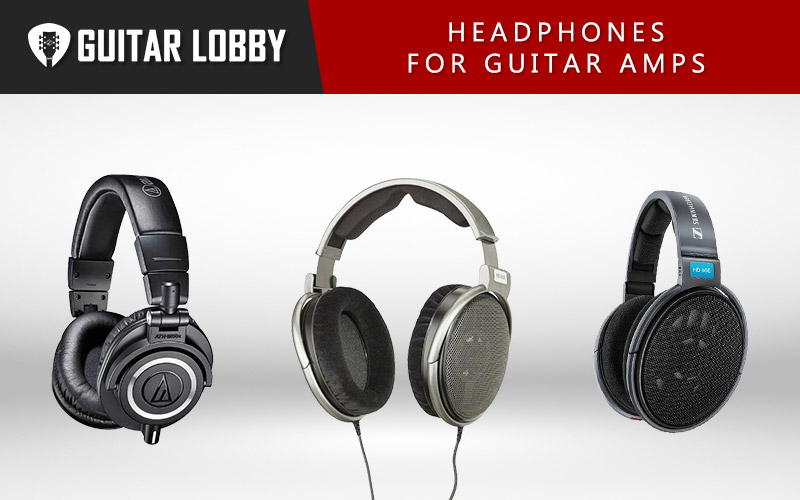
In this article, we’ll outline our favorite headphones and help you select the right ones for your needs. If you’d prefer to learn more about what to look for before diving straight to product reviews, start with our buying guide at the bottom of the page.
| Name of Product | Image of Product | Description | Price Range | Full Review |
|---|---|---|---|---|
| 1. Audio Technica Ath M50x (Best Value) | 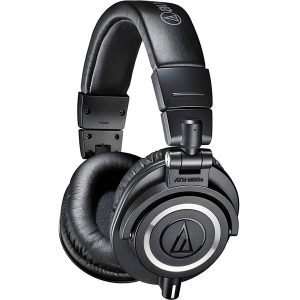 | Type: Over-ear Frequency Response: 15 Hz to 28 kHz | $150 | Read Full Review Below |
| 2. Sennheiser HD 650 (Best Overall) | 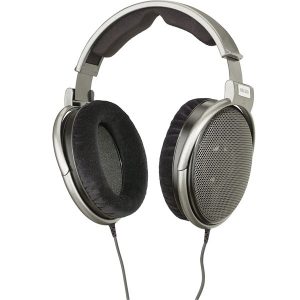 | Type: Over-ear Frequency Response: 10 Hz to 39 kHz | $400 | Read Full Review Below |
| 3. Beyerdynamic DT-770 Pro (Best Under $200) | 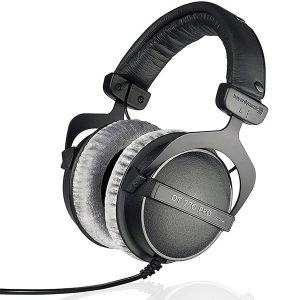 | Type: Over-ear Frequency Response: 5 Hz to 32 kHz | $160 | Read Full Review Below |
| 4. Sony MDRV6 (Best Under $300) | 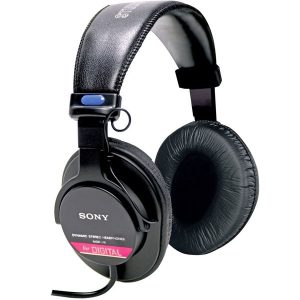 | Type: Over-ear Frequency Response: 10 Hz to 20 kHz | $300 | Read Full Review Below |
| 5. Sony MDR7520 | 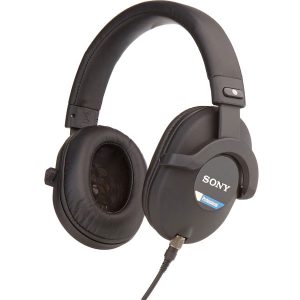 | Type: Over-ear Frequency Response: 10 Hz to 20 kHz | $500 | Read Full Review Below |
| 6. Beyerdynamic DT-880 Pro | 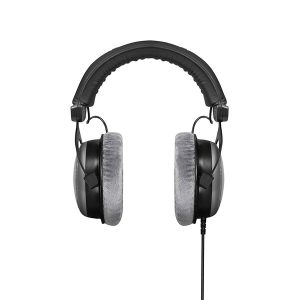 | Type: Over-ear Frequency Response: 5 Hz to 35 kHz | $200 | Read Full Review Below |
| 7. AKG K-240 | 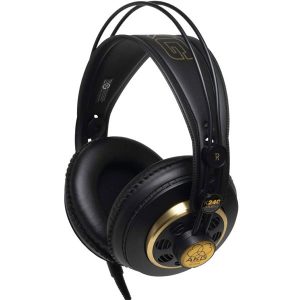 | Type: Over-ear Frequency Response: 15 Hz to 25 kHz | $70 | Read Full Review Below |
| 8. Edifier H-850 | 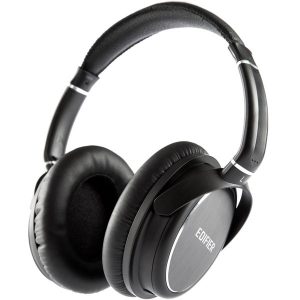 | Type: Over-ear Frequency Response: 20 Hz to 20 kHz | $40 | Read Full Review Below |
| 9. Samson SR-850 | 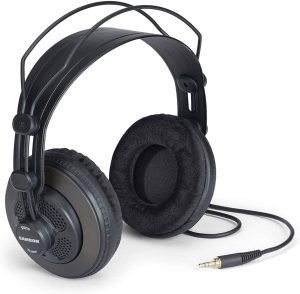 | Type: Over-ear Frequency Response: 10 Hz to 30 k | $40 | Read Full Review Below |
| 10. Status Audio CB-1 | 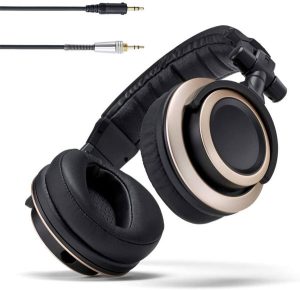 | Type: Over-ear Frequency Response: 15 Hz to 30 kHz | $60 | Read Full Review Below |
| 11. Shure SRH840 | 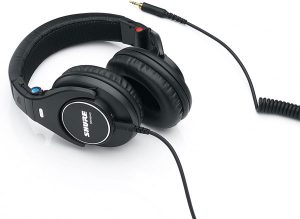 | Type: Over-ear Frequency Response: 5 Hz to 25 kHz | $150 | Read Full Review Below |
| 12. Sennheiser HD-600 |  | Type: Over-ear Frequency Response: 12 Hz to 39 kHz | $350 | Read Full Review Below |
| 13. Sony MDR7506 | 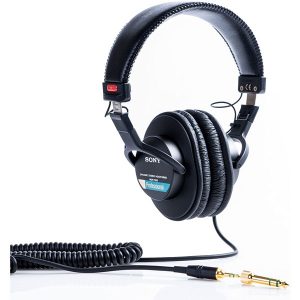 | Type: Over-ear | $90 | Read Full Review Below |
| 14. Yamaha HPH-MT5 | 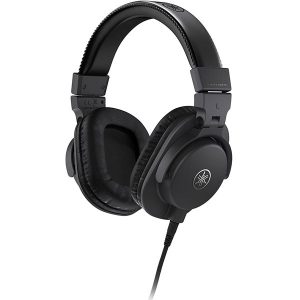 | Type: Over-ear Frequency Response: 20 Hz to 20 kHz | $100 | Read Full Review Below |
| 15. Grado SR80e Prestige Series | 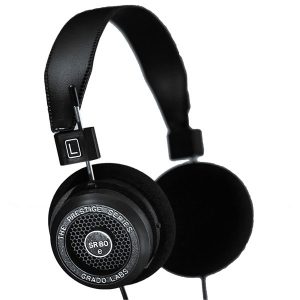 | Type: Over-ear Frequency Response: 20 Hz to 30 kHz | $90 | Read Full Review Below |
| 16. Philips X2 27 Fidelio | 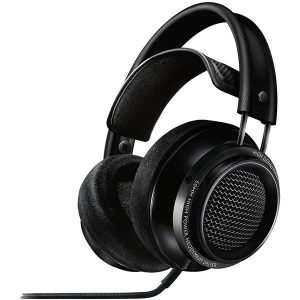 | Type: Over-ear Frequency response: 4 Hz to 40 kHz | $160 | Read Full Review Below |
| 17. AKG K553 MKII | 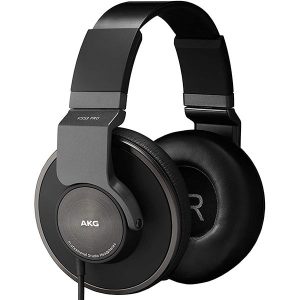 | Type: Over-ear Frequency response: 12 Hz to 28 kHz | $200 | Read Full Review Below |
Here Are the Best Headphones for Guitar Amps
1. Audio Technica Ath M50x (Best Value)
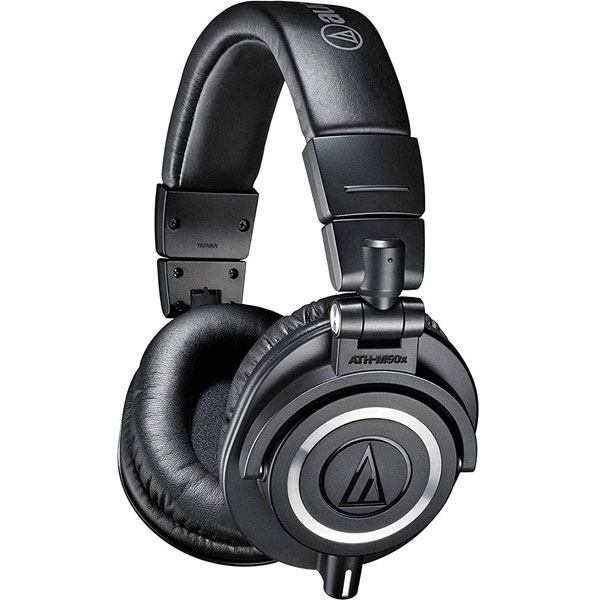
| Estimated Price | $150 |
| Type | Over-ear |
| Frequency Response | 15 Hz to 28 kHz |
| Impedance | 38 Ohm |
My Review: When it comes to headphones for audio professionals and musicians, these are some of the most celebrated models of all time. They’ve been in such high demand over the last few years, that the guys at Audio Technica decided to redesign the whole “M-Series”. They still offer the clarity, extended frequency range, and amazing bass response that has made these headphones so popular as bass guitar headphones, but also adds notable improvements when it comes to providing better isolation, rotary phones, and overall a more robust construction.
Key Specs and Features: When it comes to design, the headphones adapt an over-ear style that creates the perfect seal around your ears. The ear cups can swivel to 90 degrees, so you can take one side off, and maintain your awareness of your surroundings while mixing your favorite music. The frequency response spans across a 15 Hz-28 kHz range, which gives musicians a wider range of tunes to work with and more control over their equalizer settings. The headphone’s impedance is not as impressive, though, sitting only at 38 ohms. This low input may not fit well with some studio-quality devices like high-end microphones. Nevertheless, it’s more than enough for all guitar amplifiers. The headphones fold for easy storage and they come with 3 types of cable, a 3m curly one, and two straight ones of 1.2 and 3m. This is just great if you tend to practice in different spaces, and sometimes need to move around. It’s also super convenient if you’re going to make these your carry-on headphones for guitar amp while traveling or commuting.
Target Customer: The Audio Technica M50x keeps the bass response balanced across the board, emphasizing the mids and highs. Guitarists who primarily play bass-heavy music might not appreciate this well-balanced profile, as they are looking for more pronounced, punchy bass.
Bottom Line: The Audio Technica Ath M50x offers everything you could expect from closed-back professional headphones at a reasonable price. They’re truly the only option on their price range that features such versatility when it comes to design.
2. Sennheiser HD 650 (Best Overall)
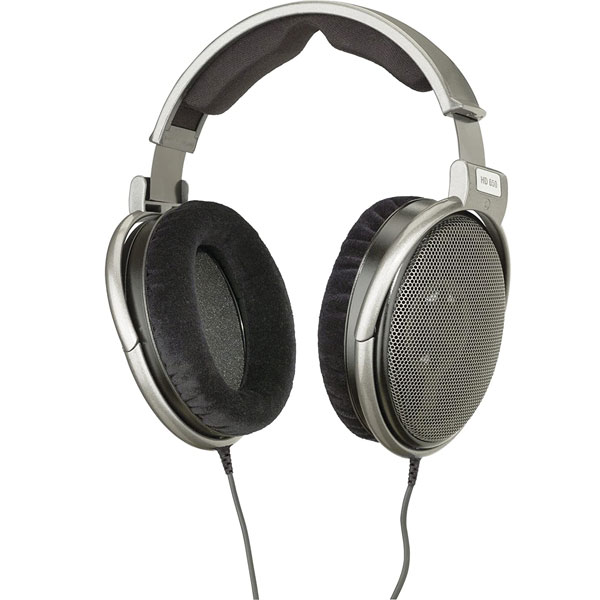
| Estimated Price | $400 |
| Type | Over-ear |
| Frequency Response | 10 Hz to 39 kHz |
| Impedance | 300 Ohm |
My Review: The Sennheiser HD650 has been around for a while and has certainly achieved a high reputation among both domestic and professional users. These headphones can work well when combined with a guitar amp. You will get a solid response and a solid quality sound.
Key Specs and Features: The HD 650 are open back, meaning the earcups are not domes of plastic, but rather create a larger, breathable space around your ears. This works very much to the HD 650’s advantage because it allows for air to flow, meaning your ears won’t get hot during extended listening sessions. This also creates a nice, natural sound stageLike many other headphones at this end of the price spectrum, the focus was on sound quality. As such, a lot of attention to material detail was done in the sound-producing areas. The neodymium drivers appear to be high quality, but Sennheiser has even included something they’re calling “specially designed acoustic silk” to help dampen artifacts and keep the harmonic distortion low. These materials are both premium (as shown by the price tag) and beneficial to playback, as evidenced by the sound quality you can get. The frequency rate of these headphones is 10 Hz to 39,500 Hz or 10 decibels. There is a little high-frequency unevenness in the HD650, which shows up mostly in cymbals and similar sounds, but one soon gets used to it. Transients are crisp and well defined, while decay into the ambiance is very natural.
Target Customer: You can use this set of headphones for both studio and your guitar amp. The headphones have enough bites to perform well when you are playing over your amp.
Bottom Line: For your money, you get headphones with their specialty acoustic silk. These are hands down some of the nicest headphones that I’ve ever tested.
3. Beyerdynamic DT-770 Pro (Best Under $200)
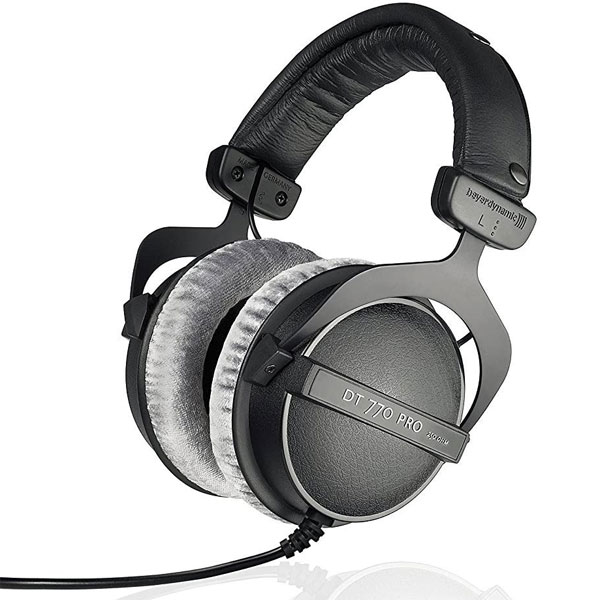
| Estimated Price | $160 |
| Type | Over-ear |
| Frequency Response | 5 Hz to 32 kHz |
| Impedance | 250 Ohm |
My Review: Produced in Germany, Beyerdynamic says these headphones have a level of workmanship that adds to their robustness and durability. Even if you’re regularly hard on your headphones, the DT 770 Pro phones should hold up with everyday use. If you’re going to be using your headphones for your guitar amp, then there’s a good chance that the durability of the design will come in handy.
Key Specs and Features: The first thing you probably noticed was the extremely comfortable silver cushions. Soft velour ear pads are circumaural and will make you want to wear these headphones for hours at a time. You won’t complain of head pain if you do. The headphones include replaceable cushions and cables. The high-resolution quality sound you get from these phones means you can use them for stage and studio recordings and still have amazing clarity during the performance. A great thing about these closed-back headphones is that they’re used for pretty much everything and different types of playing – acoustic guitars, electric guitars, bass guitars, and more. These headphones can produce nominal sound pressure at a level of 96 decibels. They include type-wired transmission and have a frequency response of 5 Hz to 32,000 Hz. The low end you hear from these things is very well defined and clear, almost as if you had a subwoofer somewhere in the room, but they achieve this effect without overdoing it. The bass response, and not a bass enhancement, so these are good even as mixing monitors. The Beyerdynamic DT 770 Pro headphones come in two colors, gray or black.
Target Customer: These headphones have a single-sided cable that is perfect for guitar amps and are meant for everyday use in the studio or rehearsal space.
Bottom Line: Overall, these are a premium pair of headphones for guitar amps. They offer exceptional build quality and excellent audio fidelity. If you’re looking for a pair of headphones that will last you for years, then the Beyerdynamic DT770 Pro’s are the industry standard.
4. Sony MDRV6 (Best Under $300)
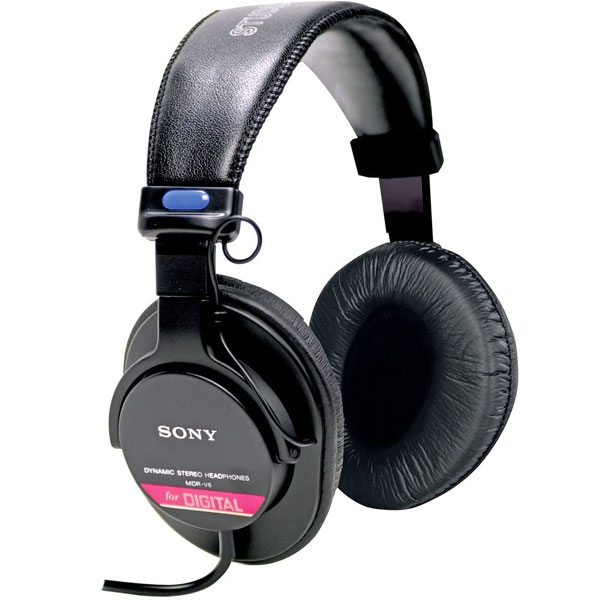
| Estimated Price | $300 |
| Type | Over-ear |
| Frequency Response | 10 Hz to 20 kHz |
| Impedance | 63 Ohm |
My Review: MDR stands for Micro Dynamic Receiver, a trademark of Sony. The first MDR’s were introduced as far back as 1985 and quickly became popular with audio engineers and disc jockeys for being a cost-friendly option of truly flat headphones that could sustain a lot of abuse and travel. Now, the MDRV6 headphone model still stands as a go-to for many professionals in audio.
Key Specs and Features: These are over-the-ear, closed-back headphones with wide frequency response. Their oversized diaphragm adds to their professional look, feel, and sound as well. The wired connectivity of these sleek headphones makes it easy to plug into a guitar amp or other device and get listening. . Their design is lightweight, unobtrusive, and fit perfectly on your head. The earpads are soft and breathe nicely so your head doesn’t get too warm. Once you slip these phones on, you’ll appreciate the frequency response, which is between 10 Hz and 20 kHz. They have an impedance of 63 ohms. The included cord is 9.8 feet long. It also has a gold-plated plug sure to hold up to all the times you put it in your amplifier. Sony included 40-millimeter drivers and magnets made of neodymium to improve the detailing and quality of your sound. You’ll also notice that everything you hear has more power compared to using other headphones. The only con from our point of view is that the cable is not detachable, which, as we’ve said before, means that if your cable ever develops a false contact, you either have to go through the nuisance of getting them repaired or just getting a new pair.
Target Customer: These are great for just about anything. Most engineers wouldn’t go as far as to master with these, maybe only use them as reference headphones, but if you’re thinking about mixing, recording, Djing, playing guitar or bass, or just pleasure listening, these are an industry-standard by now.
Bottom Line: While the audio fidelity is not as mind-blowingly clear as some of the more expensive headphones on this list, they’re adequate, considering their price. In my opinion, these are the best guitar headphones under $300.
5. Sony MDR7520
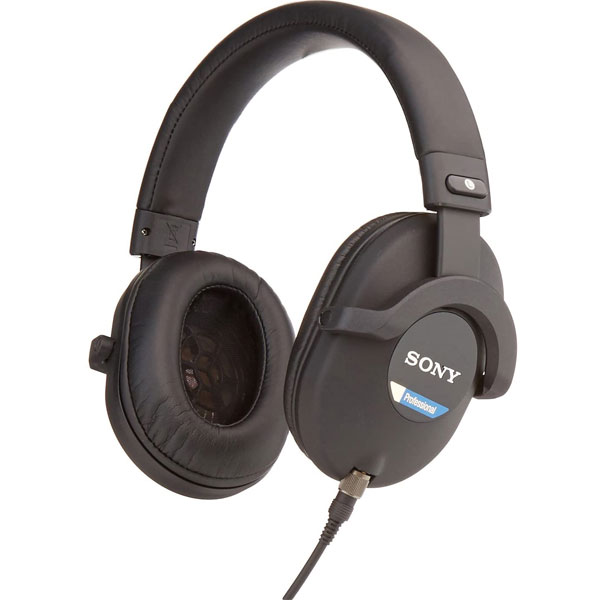
| Estimated Price | $500 |
| Type | Over-ear |
| Frequency Response | 10 Hz to 20 kHz |
| Impedance | 63 Ohm |
My Review: If you’re a fan of Sony products, then we suggest trying their MDR7506 professional large-diaphragm headphones. While the audio fidelity is not as mind-blowingly clear as some of the more expensive headphones on this list, they’re adequate, considering their price.
Key Specs and Features: The wired connectivity of these sleek headphones makes it easy to plug into a guitar amp or other device and get listening. They have a closed-ear design and a secure fit so they don’t fall off your head as you’re nodding along to the music. Their oversized diaphragm adds to their professional look, feel, and sound as well. Their design is lightweight, unobtrusive and fit perfectly on your head. The earpads are soft and breathe nicely so your head doesn’t get too warm. This model has an excellent mid-range frequency response with a stellar bass response to match it. The only average part of this model is the treble range.
While it’s better than with most other models in the same price range, it may come off a bit hissy when listening to treble-heavy songs. Once you slip these phones on, you’ll appreciate the frequency response, which is between 10 Hz and 20 kHz. They have an impedance of 63 ohms. The included cord is 9.8 feet long. It also has a gold-plated plug sure to hold up to all the times you put it in your amplifier. Sony included 40-millimeter drivers and magnets made of neodymium to improve the detailing and quality of your sound. You’ll also notice that everything you hear has more power compared to using other headphones. These headphones come with a 3m coiled cable that’s not detachable, as well as a 1/4” jack adapter. This is a foldable model, which means that you can collapse the cups inward to save storage space when you’re not using them.
Target Customer: If you’re going to be using these headphones with your guitar amp, you’ll have no problem jamming out for long sessions at a time. Sure, you won’t get the most natural sound despite the wide frequency response and high power handling capacity. But it would be unrealistic to expect top-end performance at such an affordable price tag.
Bottom Line: These are an excellent pair of budget headphones for guitar amps. The MDR7520 is an all-around headphone to get your hands on if you want to hear music the way the recording engineer heard it without breaking the bank.
6. Beyerdynamic DT-880 Pro
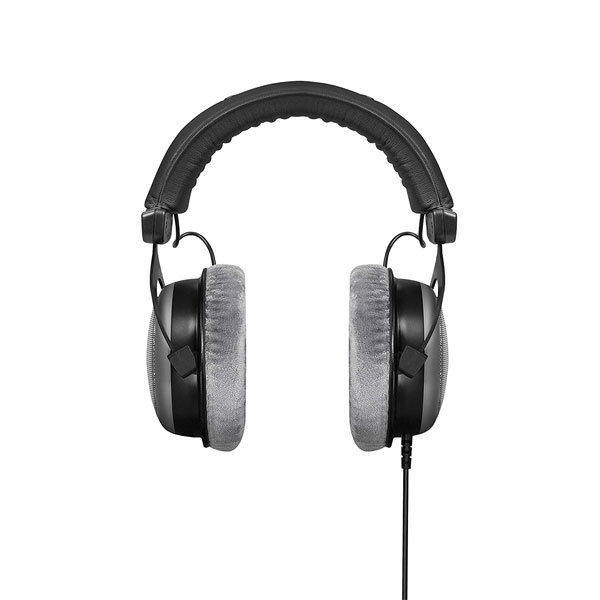
| Estimated Price | $200 |
| Type | Over-ear |
| Frequency Response | 5 Hz to 35 kHz |
| Impedance | 250 Ohm |
My Review: Designed for studio use, the DT-880 Pro presents itself as a semi-open headphone praised for its natural and neutral sound. These are great and comfortable headphones that can be used in various scenarios. Beyerdynamic is truly one of the best brands out there in the headphone market.
Key Specs and Features: Comfort is ensured by the permeable ear cup design and adjustable, padded headband, while the circular ear pads provide exceptional acoustic accuracy by preventing external sounds from disturbing you. These headphones have a very high impedance of 250 Ohms. The semi-open design allows for a very natural-sounding soundstage effect, resulting in a very immersive listening experience. On top of that, you get a very flat, faithful reproduction that highlights even the tiniest details in your playing. The DT-880 Pro excels at mid ranges, but the bass and treble are also very good. There’s some hissing when listening to treble-heavy tracks, but it shouldn’t be a problem if you’re using it with your guitar amp. It has a wide frequency response ranging from 5 Hz to 35 kHz. The low 5 Hz frequency speaks for a deep and precise bass range, and, in turn, a more pronounced mid-range. But, due to a high 35 kHz, some tracks may sound hissy in the treble range when the volume is turned to the max. The single-sided plug coiled connection cable comes with both a mini-jack and ¼-inch jack adapter.
Target Customer: Regardless of the use, you’ll most likely be impressed by the wide stereo image and balanced sound that make the DT 880 Pro a reference point for audio engineers and producers alike. You can use these headphones in the studio as well as at home, to listen to your favorite music, recorded instruments, or for gaming.
Bottom Line: The DT-880 Pro from Beyerdynamic is on the higher end of the spectrum in terms of price. As such, it might not be your first choice if you’re on a budget. But if you’re looking for multi-purpose headphones you’ll use for hours on end, this semi-open model might be a good investment.
7. AKG K-240 (Budget Pick)
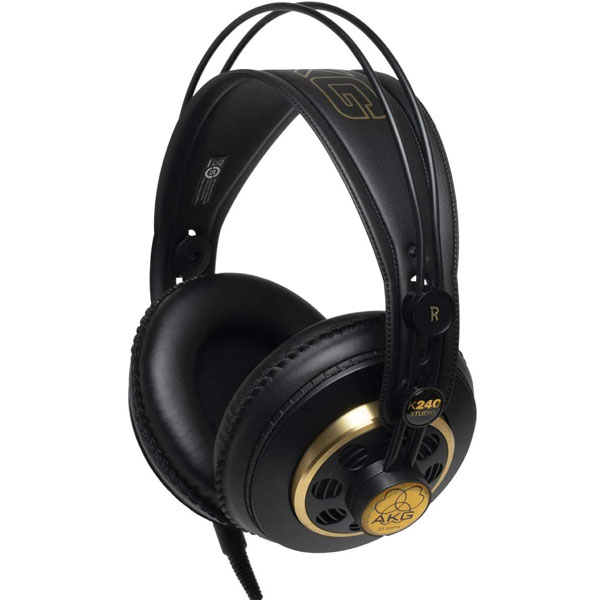
| Estimated Price | $70 |
| Type | Over-ear |
| Frequency Response | 15 Hz to 25 kHz |
| Impedance | 55 Ohm |
My Review: These over-ear headphones in a semi-open style come with a lot of cool equipment. The AKG K240 is your go-to pair of headphones that offer comparable audio performance and quality to its more expensive counterparts.
Key Specs and Features: These classically designed semi-open headphones have supersized transducers built using the proprietary Varimotion diaphragm. This ensures steady frequency response and allows for a more spatial soundstage effect. The headband has adjusting features for a fit that’s precisely matched to your head. It can even connect a single-sided cable. Both ears feature padding that should surround your ears and block out any outside noise. When you put it to the test, you’ll find that the high-frequency treble range sounds surprisingly strong. The same applies to the mid-range, but not so much to the low-frequency bass range. The bass frequencies can get a bit overloaded, resulting in a sound that’s a tad too explosive. To avoid these audio spikes, you will
Target Customer: At 55 Ohms, the impedance is somewhere in the middle of the spectrum. But even though it’s not high enough to recommend this model for studio use, it is more than adequate for your guitar amp.
Bottom Line: While the K240 model from AKG is rather inexpensive, its performance is up to par with many less affordable models out there. From mastering to mixing and listening, the AKG K240 headphones have a range of uses. You’ll want to use them for hours with how comfortable and handy they are.
8. Edifier H-850
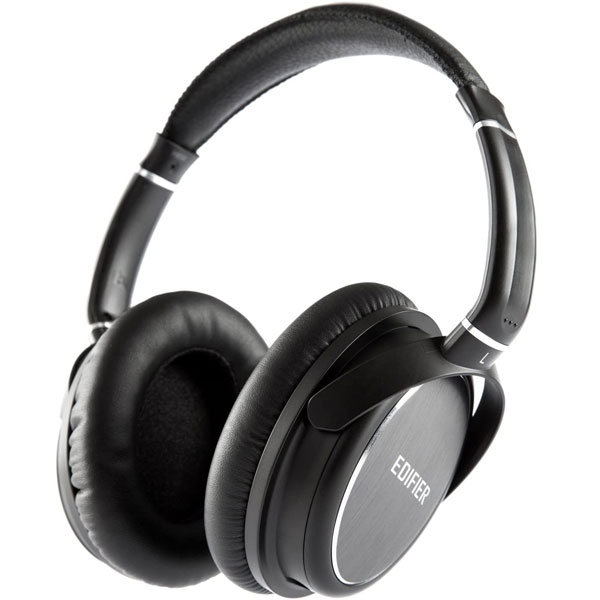
| Estimated Price | $40 |
| Type | Over-ear |
| Frequency Response | 20 Hz to 20 kHz |
| Impedance | 44 Ohm |
My Review: Edifier isn’t exactly a household name when it comes to professional audio, like, say, a Sennheiser, Audio Technica, or AKG. That’s because they’re a Chinese company that was just founded in 1996. Their focus is on keeping things low cost, while just at the right amount of functionality. If all you want to do is get a nice and clean signal from your guitar amp headphones, that do have a detachable cable, then these are worth looking into
Key Specs and Features: The Edifier H850 headphones don’t stand out in terms of design. They do however have a very solid build. The headband has metal reinforcement and you’ll also notice metal caps over the housing. The plastic housing is not of the highest quality but it is thicker than what you’ll find in other models in this price range. The cups swivel and the ear pads are replaceable which means you can customize them to your preferred level of comfort. You can also replace the cable if you want, but it’s worth noting that the standard cable has a solid locking mechanism. With a closed-back design, the Edifier H850 dramatically prevents sound leakage. Like Sony models, these are reinforced with a 40mm neodymium magnet for rich lows and clear highs. This leads us to the 20 Hz to 20 kHz frequency response. The highs are where the H850 headphones fall off a bit. This is due to the restricted ear cup design which doesn’t provide enough air for a proper extension. However, the decent sound directionality should help balance this out. The bass has enough punch until you go lower than 50Hz. The midrange is sublime and offers impressive clarity. This is what helps offset the minor refinement issues with the higher frequency range. The mids will have a difference in tonality depending on what guitar you’re using. Electric guitars come out fine, but you might experience a cold tonality when using an acoustic setup.
Target Customer: The Edifier H850 Over-the-Ear Pro is the most durable pair of headphones at this price segment. With a moderate frequency response, sturdy build, and foldable design, these headphones are destined to be with you anywhere you go.
Bottom Line: At the end of the day, the Edifier H850 headphones won’t win you any beauty contests. However, they’re very light and have a well-balanced sound for the modest price tag.
9. Samson SR-850
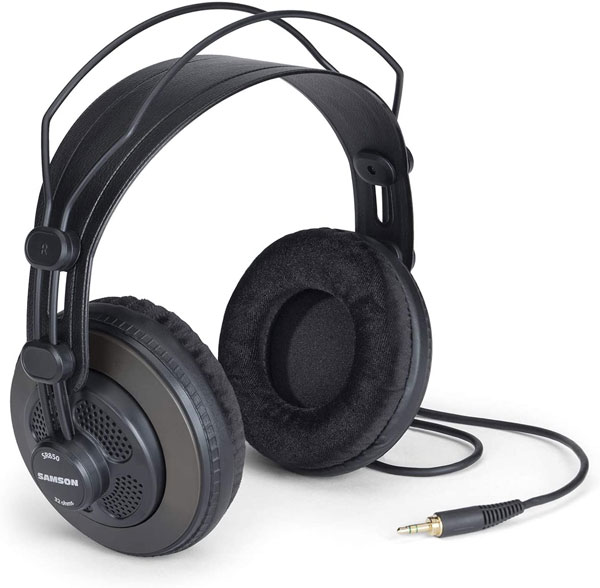
| Estimated Price | $40 |
| Type | Over-ear |
| Frequency Response | 10 Hz to 30 kHz |
| Impedance | 32 Ohm |
My Review: Some guitarists just want a pair of headphones that sound as neutral as the original amp sound. The Samson SR 850 has it all, with some other features. The Samson SR850 is famous for delivering the most neutral tone, just like a stand-alone amp would.
Key Specs and Features: This lightweight model features a self-adjustable headband for a snug fit according to your ears’ position, and the ear cups are cushioned with soft velour for extra comfort. While the construction is a bit lightweight, for this modest price range the SR850 shows a promising level of durability. The Samson SR 850 has a 32-ohm impedance level, the ideal value for guitar amps. These headphones also give off more realistic highs and mids. The headphones use 50mm drivers which gives them a nice dynamic range. However, the open back design will limit the performance of the drivers in various settings.
An entry-level pair like this is very impressive regarding tone neutrality. You’ll appreciate this later when you’re able to spot out separate instruments easily in the playback. For the most part, these Samson headphones deliver on their promise of creating a very neutral sound. The rated frequency range of 10Hz to 30kHz is pretty standard. Combined with Samson’s proprietary 50mm drivers, the bass range promises deeper low notes. The stock cable is non-detachable. But the stock version shouldn’t affect the performance at all. The gold plated adapter is a standard 1/8” and it comes with a 1/4” adapter.
Target Customer: Instead of buying a generic pair with unknown impedance, these headphones are the absolute go-to for guitarists who crave an entry-level pair just to practice and notice every instrument in a playback.
Bottom Line: If you want a pair of headphones specifically to connect them to your guitar amplifier, you probably won’t regret these. In the end, it will be a matter of personal preference here, as plenty of musicians find the SR850 to be quite comfortable.
10. Status Audio CB-1
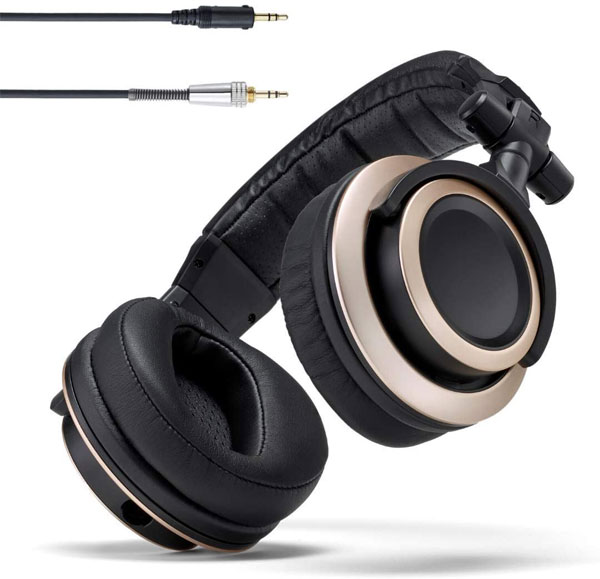
| Estimated Price | $60 |
| Type | Over-ear |
| Frequency Response | 15 Hz to 30 kHz |
| Impedance | 32 Ohm |
My Review: With its large over-ear design and comfortable pads, the CB-1 is very promising, at least as far as comfort goes. They’re mostly advertised as studio monitors which have some validity due to how chunky they look. The Status Audio CB-1 has all the qualities you would need for your guitar amp, the quality is good and the sound is solid.
Key Specs and Features: This pair features a closed-back construction, thus offering excellent noise isolation, which guarantees no sound leakage or any distracting noise whatsoever. This pair’s ergonomics is meant for added comfort. The over-the-ear design ensures that your ears are entirely encompassed for extra isolation. It features a padded, adjustable headband. The earpads are overstuffed with memory foam to reduce ear fatigue. It supports a narrower 15 Hz to 30 kHz frequency range. That’s the reason why the bass response is a little bit off here. The 50mm drivers, which add depth to the bass notes and the mids sound warmer than they should be, and the highs are bright. Don’t worry if the bass range is a tad clumsy since this pair boasts decent stereo imaging, which is responsible for mixing low, mid, and high frequencies. Rated at 32 ohms, the impedance level is the golden standard for a guitar amp.
Target Customer: This pair is better reserved for audiophile use rather than advanced studio tasks. If you’re a bass-head, you probably won’t like the bass range here because of the 15 Hz to 30 kHz frequency response.
Bottom Line: These headphones are pretty much what you would expect if you were to eliminate the branded premium. The sound scale is impressive and the no-name branding keeps the price low. For a low-cost home studio recording setup, the CB-1 might just be a good alternative.
11. Shure SRH840
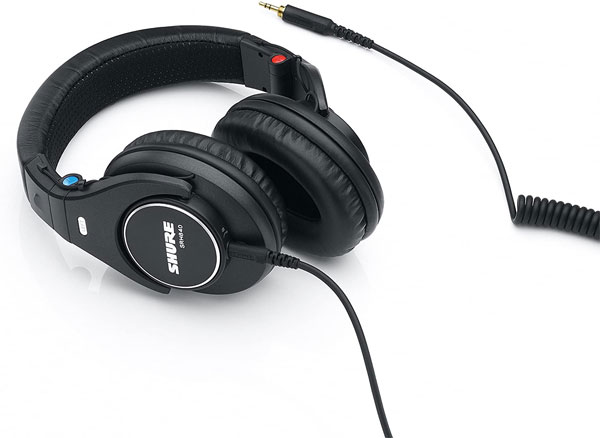
| Estimated Price | $150 |
| Type | Over-ear |
| Frequency Response | 5 Hz to 25 kHz |
| Impedance | 44 Ohm |
My Review: These are highly recommended headphones by buyers due to their comfortable built-in quality and frequency response. Shure is a very well-received brand in the world of audio equipment and these headphones live up to the brand’s reputation. They are a professional pair of headphones with excellent sound quality, comfort, and durability.
Key Specs and Features: These are On-Ear headphones with comfortable foam and suitable ear cup sizes. One can wear it comfortably for long hours while working. The SRH840 are excellent headphones for guitar amps because they come with everything you need to get listening and recording right away. Striving for accuracy and detail, the Shure SRH840 are very clear-sounding, slightly bright-leaning headphones. They have a great top-end, which is both insightful and a little unforgiving at times. You get a user guide, replacement ear pads, a carrying bag, and a threaded gold-plated adapter that’s ¼ inches. The included coiled cable can detach if you want to use your cable with these headphones.
Target Customer: Ideal for critical listening and studio recording, Shure’s headphones will lengthen your highs, boost your mid-ranges, and make your bass guitar sound more prominent. No matter the genre of music you like to play these headphones should more than suffice.
Bottom Line: These are tailored frequency headphones for buyers who want a budgetary product. It delivers clear sound and high-frequency ranges. Its ambient sound makes them amazing to be used for long hours.
12. Sennheiser HD-600

| Estimated Price | $350 |
| Type | Over-ear |
| Frequency Response | 12 Hz to 39 kHz |
| Impedance | 300 Ohm |
My Review: Sennheiser is one of the most acclaimed studio-quality headphone brands, and their HD 600 model is an exceptional choice if you’re after a pair of high-quality yet wallet-friendly guitar headphones.
Key Specs and Features: Performance apart, we also like how comfortable these headphones are. The sophisticated design and elegant finish incorporate useful details, such as cushioned earpads and adjustable cushioned headband. The high-quality open-ear cups with metal mesh covers not only enhance aesthetics; they also deliver an extremely transparent sound. While there will be some sound leaks in the room, the HD 600’s acoustic is excellent. Impedance is 300 ohms which pair with one of the wider frequency ranges you’ll see at 12 – 39000 Hz, meaning you’ll hear every detail of your guitar’s tone. Optimum sensitivity and dynamics are also ensured by the neodymium magnets and lightweight aluminum voice coils. Another nice feature is the computer-optimized magnet system designed to minimize both intermodulation and harmonic distortion. The kevlar coated copper cable is lockable and detachable, while the unit ships with a 3.5mm adapter, allowing you to plug it into nearly any device.
Target Customer: This audiophile-grade, open dynamic stereo headphone boasts an advanced diaphragm and is ideal to use in a studio. Music from your MP3 player and guitar from a preamp both sound full and satisfying.
Bottom Line: If you have the budget, these are some of the best headphones money can buy.
13. Sony MDR7506
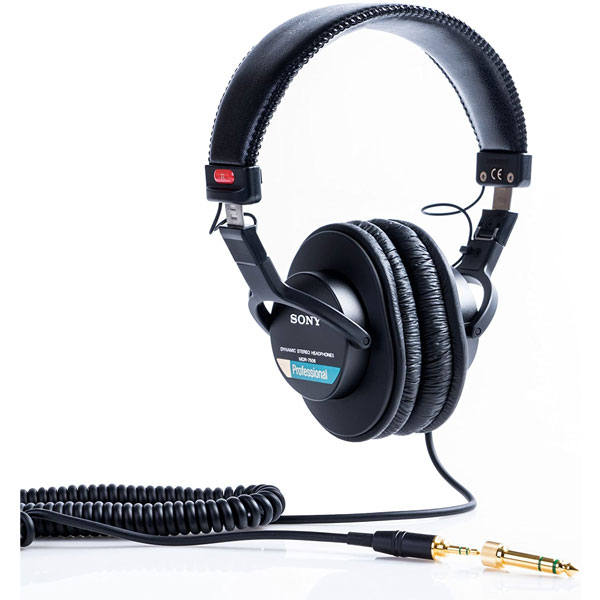
| Estimated Price | $90 |
| Type | Over-ear |
| Frequency Response | 10 Hz to 20 kHz |
| Impedance | 63 Ohm |
My Review: The Sony brand is rarely a bad bet, even when you dip into the lower price ranges, where the MDR7506 typically makes its living. If you’re a fan of Sony products, then you should try their MDR7506 professional large-diaphragm headphones. These are an excellent pair of budget headphones for guitar amps.
Key Specs and Features: They have a closed-ear design and a secure fit so they don’t fall off your head as you’re nodding along to the music. Their oversized diaphragm adds to their professional look, feel, and sound as well. One benefit to these headphones is that they are very comfortable. Their design is lightweight, unobtrusive and fit perfectly on your head. The earpads are soft and breathe nicely so your head doesn’t get too warm. While it doesn’t have the detachable cable, the MDR7506 supports both 1/8″ and 1/4″ applications via an included adapter and delivers a whopping 63 ohms of impedance, enough to handle more intense preamp audio levels. Once you slip these phones on, you’ll appreciate the frequency response, which is between 10 Hz and 20 kHz. Sony included 40-millimeter drivers and magnets made of neodymium to improve the detailing and quality of your sound. You’ll also notice that everything you hear has more power compared to using other headphones.
Target Customer: As you would expect from a Sony product, the sound quality is excellent and capturing the guitar’s tone effectively.
Bottom Line: While the audio fidelity is not as mind-blowingly clear as some of the more expensive headphones on this list, they’re adequate, considering their price.
14. Yamaha HPH-MT5
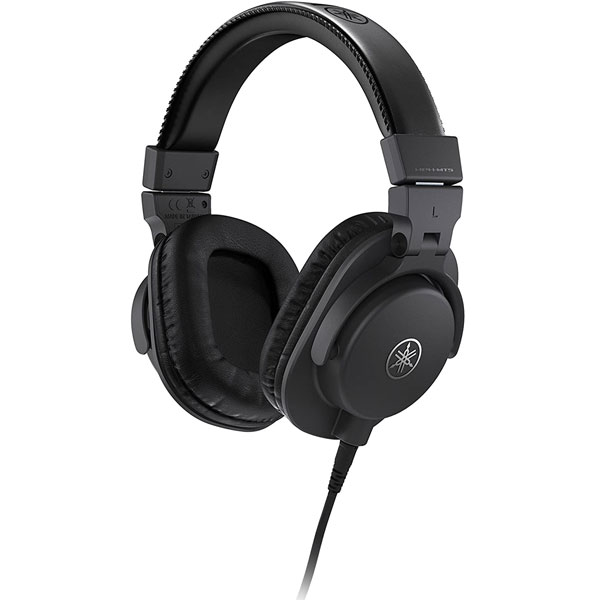
| Estimated Price | $100 |
| Type | Over-ear |
| Frequency Response | 20 Hz to 20 kHz |
| Impedance | 44 Ohm |
My Review: Yamaha has a long history of providing studio monitor solutions. Now, Yamaha aims to make its mark on the headphone market with its HPH-MT8 and HPH-MT5 headphones, by emphasizing accuracy and durability.
Key Specs and Features: The HPH-MT54 headphones are coated in synthetic leather, both on the headband and the ear pads. Those pads include cushions with low resistance. Not only does the pillow-like quality of the cushions enhance the noise isolation, but it boosts your comfort as well. One highlighted feature that both models share is the “rotatable” ear cup. You can rotate one ear 180 degrees for “single-ear monitoring”. The HPH-MT5W monitor headphones also include custom drivers at 40 millimeters for more accurate responses and a solid frequency rate. The closed-back design of these headphones will keep external sounds out so you can close your eyes and concentrate only on what you’re hearing. The MT8’s are easily adjustable and come with two lock-in-place connector cables. The HPH-MT5 headphones feature custom drivers with an impressive frequency range of 20 Hz to 20 kHz. The MT5’s are clear, but with a more center-focused sound. Sonically, the MT5’s don’t sound quite as open as the MT8’s, and are darker by comparison. That said, they do possess a full sound and good low-end response. The HPH-MT5 monitor headphones include a standard stereo plug adaptor that’s 6.3 tiny millimeters. The MT5’s are stocked with a single 3-meter straight cable, gold-plated adaptor, and a Yamaha carrying bag.
Target Customer: The robust build quality of the HPH-MT5’s makes them a strong choice for tracking scenarios where headphones may take a bit more of a beating than in a mixed situation.
Bottom Line: As sleek and professional as they come, the Yamaha HPH-MT5 monitor headphones can become your new best friend in the studio. These are some of the best pairs of headphones for guitar amps out there.
15. Grado SR80e Prestige Series
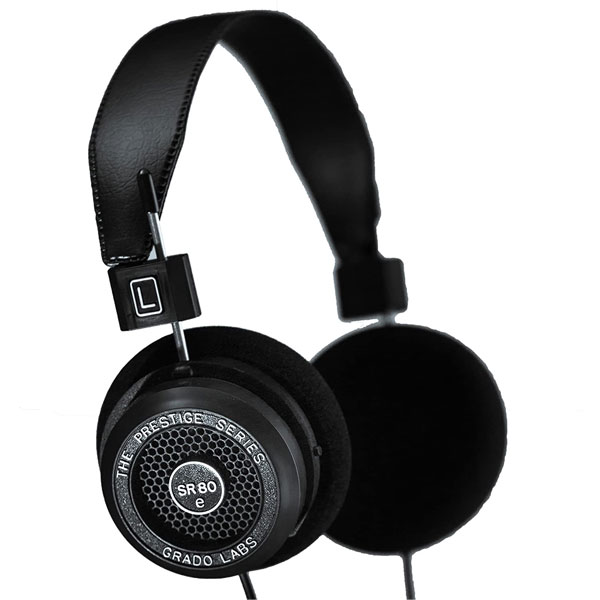
| Estimated Price | $90 |
| Type | Over-ear |
| Frequency Response | 20 Hz to 20 kHz |
| Impedance | 32 Ohm |
My Review: Last but certainly not least, we’ve got the Grado SR80e Prestige Series headphones. These are lively headphones with excellent midrange and treble detail, as well as swift, deep bass for a pair of this size and style. The bass is clean and punchy and there’s zero sense of one frequency band bleeding into or encroaching upon another.
Key Specs and Features: The headband is made of metal but includes a vinyl cover that’s plush and comfy. You can adjust the vinyl as needed so it covers your head. The ear cushions are designed bigger so they cup your entire ear as well. This makes those long hours of recording and listening back far less arduous. Open-back on-ear headphones are a rarity and these pair show unwavering confidence in their unusual approach. With awesome sound, the SR80e phones have their adaptor that’s ¼ inches with a mini stereo plug. The connecting cord that comes with these headphones is made of copper, as is the voice coil wire. The included air chamber reduces resonance, and there’s a powerful vented diaphragm as well. With a four-conductor connecting cable, the sound you get from these headphones is described as more open. The frequency response on these headphones is 20-30 kHz and the impedance is 32 Ohm.
Target Customer: The SR80e is a good choice for guitarists that want to try out affordable headphones with their amp. The quality of the sound combined with the comfort will make you appreciate them while doing your recording or practicing sessions.
Bottom Line: These Grados are a bit of a weird kid, but the sound is fantastic. Their dynamics, detail, and clarity are all-but-unmatched at the price.
16. Philips X2 27 Fidelio
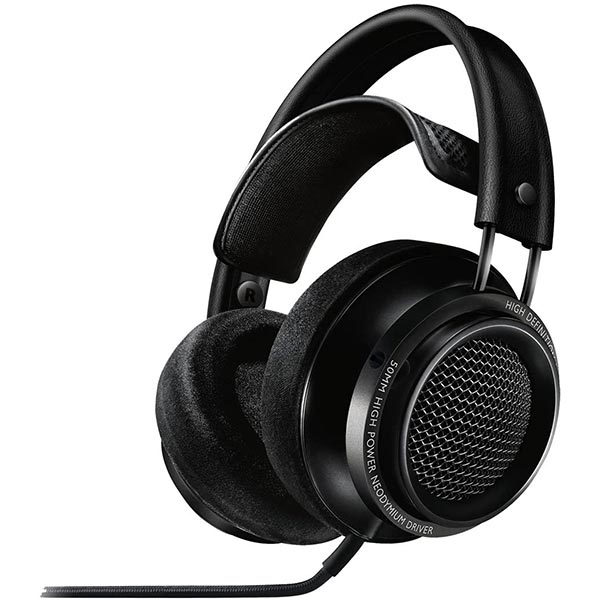
| Estimated Price | $160 |
| Type | Over-ear |
| Frequency Response | 4 Hz to 40 kHz |
| Impedance | 30 Ohm |
My Review: The Philips Fidelio X2s headphones have a big reputation to live up to. Philips has decided against going back to the drawing board for the winning formula, instead opting to tweak its existing model. Although the Philips X2/27 Fidelio doesn’t feature any noise isolation, the open-back acoustic construction allows you to hear the beauty of your playback with an excellent Hi-Fi sound.
Key Specs and Features: This pair is constructed in an acoustic open-back architecture, which sacrifices isolation for a spatial Hi-Fi audio experience. The X2s are a classy all-black affair and in terms of build, comfort, and looks. The over-the-ear design means larger cups that can accommodate your ears. Additionally, the earpads are stuffed with memory foam for added comfort. The pair also features a self-adjustable hammock for a snug fit. The leather headband is as strong as ever and the familiar mesh band sits below for your comfort. It has a frequency response ranging from 5 Hz to 40 kHz, making it the only pair with the most expansive frequency range on the list. Owing to an incredibly low 5 Hz, the bass response may sound explosive. Thanks to the 50mm neodymium drivers, the dynamic range is enhanced for better stereo imaging. This pair comes with a high-res audio feature on board, which filters out the unwanted noise from your playback. As for impedance, it’s rated as 30 ohms, which is adequate for a guitar amp. They’re good to function as studio-gear headphones, but not for extended periods. The jack is now 3.5mm too, though a 6.3mm adapter is included.
Target Customer: The Philips X2/27 Fidelio is the solution for guitarists who look for a Hi-Fi playback to what they’re playing on the neck.
Bottom Line: If you’re looking for unrivaled comfort and an eye-pleasing design to boot, there’s none better.
17. AKG K553 MKII
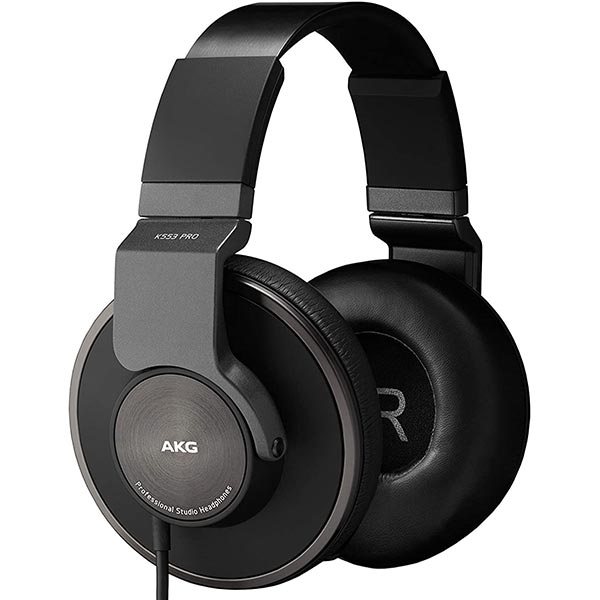
| Estimated Price | $200 |
| Type | Over-ear |
| Frequency Response | 12 Hz to 28 kHz |
| Impedance | 32 Ohm |
My Review: The AKG K553 MKII is a surprising headphone designed to perform well with all connections thanks to its low impedance drivers and excellent noise isolation.
Key Specs and Features: The headphone is lightweight, over-ear design features advanced closed-back technology that blocks outside noise and also prevents sound leakage into the environment. Outstanding build quality is ensured by the metal and faux leather materials that characterize the design. The earpads are large enough to cover the whole ear, while the plushy feel enhances comfort even when wearing the headphones for several hours. The closed-back design sounds awfully like an open back but does an excellent job of preventing outside noises from disturbing you. The low impedance of only 32 Ohms means that you can plug the AKG K552 Pro into any computer or amp and they’ll sound great.
Additionally, the frequency range goes from 12 Hz up to 28000 Hz. This may not be the widest range as far as professional headphones are concerned, but it eclipses what casual headphones have to offer. They provide good sound isolation and an expansive soundstage. Every note is clear and every instrument distinct, giving the overall sound a spacious feel. And here is where the versatility truly kicks in. These are wired headphones and the cable is not detachable. It’s only three meters, which is excellent in a studio or even in your house if you want to move around a little with the headphones on. The cable is good, not causing any interference, and comes with a neat 6.3 mm adapter.
Target Customer: In short, the AKG K553 Pro headphones are an excellent example of studio-grade headphones with universal appeal. If you are a guitar player and an audiophile at the same time, you will love them.
Bottom Line: Excellently priced for their performance, the headphones are hard to beat. All in all, the headphone delivers a wonderful listening experience at a fraction of the cost of a professional choice.
Choosing the Right Guitar Headphones for Practicing
When looking for the best headphones for your amp you will come across terms like frequency range, impedance, or the mention of a headphone amp.
While you don’t have to know what they mean to make a good purchase and reap all the benefits of practicing with headphones for guitar amps, we are going to go into these terms and what they are.
Dynamic Frequency Range
You shouldn’t use regular headphones with your guitar amp. For the most part, the standard earphones you use to listen to music on your portable player have a very limited dynamic range. They are thus not equipped to reproduce the nuances in your playing.
When looking for a good pair of headphones to use with a guitar amp, you want a model that can give a highly accurate reproduction. To achieve that, it needs a wide-range frequency response.
Frequency range means how many frequencies each pair of headphones is capable of reproducing. Simply put, the higher the better. Frequency response is the frequency range that the headphones can produce from the audio source. That’s why you need to buy designated headphones for your amp since generic headphones offer poor frequency responses.
The wider the frequency range, the more subtleties you can hear in your playback. Generally, a minimum of 15 Hz works fine with guitar amps. However, some headphones support frequencies ranging from a deep 5 Hz to a bright 30 kHz if you’re looking for more pronounced low tones.
Some pairs have ear cups reinforced with 50mm neodymium-magnet drivers, which contribute to better stereo imaging and sound reproduction.
Headphone Impedance
Impedance is another important thing to consider when buying headphones for practicing your electric guitar. It’s an electrical unit that represents the relationship between resistance and reactance. To put it in simpler terms, low impedance headphones (below 25-30 Ohms) only work well with devices that have low amplification.
Impedance, when it comes to headphones, means the power that they require to deliver certain audio levels. Headphones with low impedance (around less than 25 ohms) require little power to provide decent audio levels, so they’re best used with equipment with low amplification like a phone or a laptop. Headphones with high impedance (more than 25 ohms) require more power to deliver higher audio levels, these are meant to be used with more powerful equipment than your usual home electronics. This is where the term “headphone amp” might have come in.
But because you’ll be using them with your guitar amp, you need headphones with high impedance. This helps prevent blowouts and ensures that there is no overloading when playing at higher frequencies. Moreover, high-impedance headphones also reproduce sound much more accurately, which is why they’re an essential part of studio and mixing equipment.
Headphone amps are used for people that are going to be using several pairs of headphones, usually for monitoring or mixing purposes. Higher impedance headphones work best with this sort of equipment but don’t necessarily need it to perform. That being said, your guitar amp does count as powerful equipment, as the signal it sends to your headphones for guitar amps is certainly stronger.
Noise Isolation
When you’re practicing, you need to be aware of how every pick stroke sounds. So, you’d want to cut down both the sound leakage and the distracting noise from your surroundings. For that, we’d recommend closed-back headphones. But, closed-back pairs lack authentic sound reproduction. Moreover, wearing them for extended periods may damage your ears in the long run because of the strict isolation.
On the other hand, open-back headphones generate a more realistic sound due to proper ventilation. Every note resonates as it should. Still, they offer little-to-no noise isolation since people around you can hear what you’re playing. In case you’re practicing in a quiet room with no one near you, it’s advisable to buy open-back headphones since noise isolation will be of no use. However, if you’re practicing in a jamming room, you should go for a closed-back pair so that your playback won’t interfere with other instruments in the background.
Protect your ears
A lot of headphones may flat out burn out your ears after one or two hours. If you’re serious about your practicing and recording sessions, you’ll want a design that’s easy on the ears. For this, there are a couple of things to look for. Proper padding would be the first. The next is the head support aka the headband. It has to be adjustable and it also needs soft padding.
An additional feature you may want to look out for is replaceable ear pads. Not all stock headphones are super comfy, but some of them will let you switch out the stock padding for a new one without needing special tools. Considering that there are lots of very soft and comfortable replacement earpads available online, this is one way to convert a cheap pair of headphones into a mid-range to a premium level of comfort.
Price is not always important
Generally speaking, expensive guitar amp headphones do have a better track record. However, a lot of that extra money goes towards accessories, refined designs, etc. A higher price tag doesn’t always mandate better sound clarity. That’s why focusing on performance and specs are sometimes better than judging the headphones by the brand.
That’s not to say that certain advanced drivers aren’t better than others. The point is, you need to keep an open mind, and also, you need to know what your top priority is. Do you just want a wide dynamic range or are you satisfied with average sound quality in a pair of eye-catching headphones? If the former is your main priority, then you don’t always necessarily need to shell out the highest money for the most expensive headphones for your satisfaction.
Overall comfort
The earpads shouldn’t cause abrasion if worn for a long time. Make sure the earpads are stuffed with comfortable fabrics like memory foam, for instance. For a perfect fit, it is recommended an over-the-ear design since your ears will be enclosed with no friction. Some headphones come with replaceable ear pads in case they’re worn out or punctured.
Another part to consider is the headband. Adjustable headbands are the standard in this type of headphone. Some pairs feature self-adjustable headbands that cope with your head’s position.
Regarding ear cups, it is best to go for ear cups that swivel inward. They’ll help you secure a flat fold on a desk, and they can easily be tossed in your bag without taking too much space like non-foldable pairs. However, if you’ll be practicing at home, stationary headphones will do fine.
Also, think about getting ones with detachable cables. They’re not always necessary, but it’s still good to know that you can change the stock cable if it’s damaged or strongly pulled by accident. Some headphones feature a locking mechanism (like a twist lock) that prevents cables from being detached.
Difference between headphone Out and Line Out
For those curious, the difference between a headphone out and line out can be a little difficult to explain. When discussing audio signal strength, there are generally four levels.
The weakest, ‘mic-level’, is the output created by a microphone that is often a balanced output (3 contacts in an XLR for example).
The next step up would be, ‘instrument-level’, this is the level of the signal created by a guitar or bass pickup for example and is typically unbalanced ( 2 contacts (TS) in an instrument cable for example).
The next step would be ‘line level’ this is often the level of a signal between pro level audio components, between a mixer and an effect unit for example. This signal is most often balanced ( 3 contacts (TRS/XLR).
The final step would be speaker level, this is the output from an amplifier to a speaker for example, or from a device to headphones. It is often unbalanced (2 contacts TS) for driving speakers or unbalanced stereo (TRS) for driving headphones.
If it’s documented as a ‘combo’ headphone/line out it is stereo unbalanced – probably compromising on higher impedance to drive headphones but should work at lower levels for a recording DI out. Using an appropriate DI box or interface would be important as well to get a good clean signal for recording.
FAQs
Before pulling the trigger on any particular model due to price, brand, or look, there are a few considerations you should make to ensure the wisest purchase.
Headphone jack for a guitar amp?
Most headphone guitar amps come with a jack. Using it is just a matter of getting the right adapter, which in these cases usually comes with the headphones, giving you the option of having a 3.5 mm or 6.35 mm jack.
If the amp you happen to be using does not have a headphone out, be advised that using an external speaker out isn’t the wisest thing to do, depending on the amp you have. Doing this with transistor amps does not pose any serious threats to the amp. Tube amps, however, must have a load that is matched to the amp’s output, so using the speaker output to plug headphones for guitar amps without having some sort of a dummy load to absorb the output power, could cause some damage to the amp.
Of course, if you’re somewhat of an electricity buff, this video on how to add an output jack to any guitar or bass amp might help. As another option, if you’re also considering home recording, you can just get an audio interface to record into your computer and then just mic your amp or plug it directly.
Play guitar through headphones?
You may know that headphones are usually an open ear, closed-ear, or semi-closed back. This refers to the level of isolation that they provide, with open headphones letting you listen to the environment (good if you’re playing with a band) and closed ear pairs being much more isolated, letting you hear your guitar and only your guitar.
Hence, the question of what’s your practice environment like should help you determine what type to go for. If you’re in a noisy space, like an apartment building, and want to practice during the day with something that drowns out all that external sound, the closed ears are the obvious choice.
Open ones are good if you practice in a rather quiet space and you’d like to avoid ear fatigue, which is what happens when you use isolation headphones for extended periods. If you’d like a good combination of both, as in close enough for close listening even with outside noise, the semi-closed work wonders.
What do you want in terms of sound?
This question is all about what you like to emphasize and hear when you play guitar. Are you a fan of chunky mid-frequencies or more high-end, or do you like bassy guitars? All these things should come into consideration as you try to find the headphones that match your taste.
If you’re not sure, going with a very balanced option is the wisest bet. “Balanced” refers to having no particular emphasis on any particular frequency range. This is good because it means you get to hear your guitar exactly as it sounds coming from the amp, with no tampering. That means that if you’re working on a certain sound while using these headphones, that will still sound great once you unplug them and let the sound flood into the room.
What other needs do you have?
Then there’s the question of whether you plan to give your pair of headphones more use apart from playing guitar. If you ever get into home recording, mixing stuff, or even just carrying them around with you to listen to music on your phone, you can find a pair of headphones that fulfills all those needs easily! It’s just a matter of being willing to spend a bit more, but it may well be worth it.
On a final note on how to choose headphones, a good piece of advice is to go for a pair with a detachable cable. Some people are rougher on equipment, and it’s horrible to have a perfectly good pair of headphones be ruined because of a false contact in the cable. This is less frequent with detachable cables, and whenever it happens you can spare yourself the nuisance of getting them repaired and just get a new cable, or use the spare one they came with!

My name is Chris and I’ve had a passion for music and guitars for as long as I can remember. I started this website with some of my friends who are musicians, music teachers, gear heads, and music enthusiasts so we could provide high-quality guitar and music-related content.
I’ve been playing guitar since I was 13 years old and am an avid collector. Amps, pedals, guitars, bass, drums, microphones, studio, and recording gear, I love it all.
I was born and raised in Western Pennsylvania. My background is in Electrical Engineering, earning a Bachelor’s degree from Youngstown State University. With my engineering experience, I’ve developed as a designer of guitar amplifiers and effects. A true passion of mine, I’ve designed, built, and repaired a wide range of guitar amps and electronics. Here at the Guitar Lobby, our aim is to share our passion for Music and gear with the rest of the music community.
